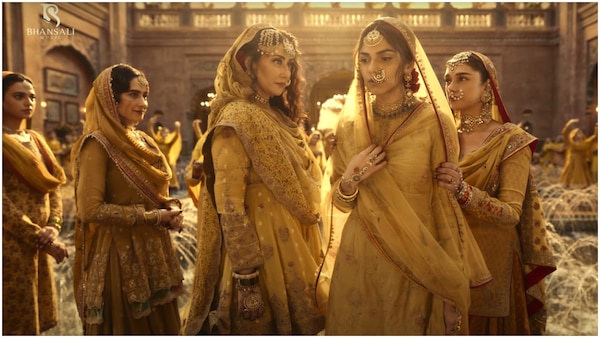Sanjay Leela Bhansali’s magic meets Amir Khusro’s devotion – Dissecting Heeramandi song Sakal Ban where art transcends centuries
Heeramandi: The Diamond Bazar is set to stream on Netflix and Sakal Ban has raised our expectations for Sanjay Leela Bhansali's show.

Last Updated: 02.29 PM, Mar 14, 2024
A group of women twirl wearing bright yellow flowy dresses; their reflection in a tinted mirror welcomes you into their world. The Madame of the brothel walks in as another woman starts dancing to a tune that finds its roots in a folklore that is over eight centuries old. That is how Sanjay Leela Bhansali chose to introduce all of us to his vision, called Heeramandi: The Diamond Bazaar, in the most Sufi way possible. Here is a group of women celebrating spring as the world gets painted in yellow around a girl who is suffering in silence, but what stands out is the poetry that laces all of these things and Amir Khusro takes over. But what exactly is Sakal Ban?
Sakal Ban From Heeramandi
A song or celebration that marks the arrival of Basant, Spring, or Sakal Ban is more than what meets the eye. Yes, it has all the Bhansali aesthetics, women representing the navras, and Raja Hasan singing the most immaculate of the words the song holds. But beneath the song is a folklore that is as old as time and only a filmmaker of Sanjay Leela Bhansali’s stature could dig that deep and find his inspiration in a man’s devotion who existed over 800 years ago. It was his dedication to make his God smile; it was his craving to see his beloved Supreme bounce back to life, and that makes Sakal Ban such a potent piece of art.
Decoding Heeramandi’s Sakal Ban
Sakal Ban, meaning every field, is penned and first performed by Amir Khusro, an Indo-Persian Sufi singer, poet, musician, and scholar. It is a song he performed to make his pir smile. Confused? Well, Hazrat Amir Khusro was a follower of Hazrat Nizamuddin Auliya, whom Khusro saw in the place of his God. Hazrat Nizamuddin, who was childless, was very fond of his sister’s son, Khwaja Taqiuddin Nuh. But destiny has different plans, as Nuh succumbed to a fatal illness and took with him Nizamuddin Auliya’s happiness.
His disciples, after the death of Khwaja Taqiuddin Nuh, were craving to see their Hazrat smile again and they did all they could. Amir Khusro couldn’t see his Hazrat grieving anymore and was ready to do anything. One fine day, when he was walking towards Nizamuddin Auliya’s Khanqah (monastery), he saw a group of Hindu women dressed in yellow, carrying yellow mustard flowers, and singing on the streets. Khusro asked them what they were doing, and they told him that they were going to the temple to offer the mustard flowers to God. Curious Amir Khusro asked them if that makes their God happy, and he got a positive response.
Without wasting a moment, he dressed up in a yellow saree, carried some mustard flowers, and appeared in front of Hazrat Nizamuddin and sang Sakal Ban. The Hazrat, looking at this dear disciple in that attire and listening to the poem, smiled and Amir Khusro’s happiness knew no boundary. From that day on, Basant Panchami is celebrated in Hazrat Nizamuddin Auliya’s shrine every year as devotees dress up in yellow clothes and sing qawwali.
Sakal Ban Transcends Centuries To Heeramandi
The folklore now makes it to Heeramandi as the poem Sakal Ban turns into a song in the album that has many more immaculate songs. The story makes you adore the details in Sanjay Leela Bhansali’s world because the women dressed in yellow, Sharmin Sehgal’s Alamzeb being sad—it all makes very much sense. But if there is one filmmaker at the moment in Indian cinema who can pull it off, it is SLB. Here is a song that joins two cultures, a testimony of religious harmony, and a piece of art that will be relevant till the end of time, and all of this meets a musician who understands the importance of culture.
Sakal Ban from Heeramandi also marks the debut of Sanjay Leela Bhansali’s music label, Bhansali Music and the fact that he chose such a culturally rich track to begin is in itself enough to tell you what he is cooking for you with this new journey. The man has served some of the grandest albums of our time, and we only expect gold from him.
Heeramandi is set to stream on Netflix this year and stars Manisha Koirala, Richa Chadha, Sharmin Sehgal, Aditi Rao Hydari, Sonakshi Sinha, Sanjeeda Shaikh, and an ensemble. For more content like this and everything else from the world of streaming and films, stay tuned to OTTplay.
(With inputs from Rana Safvi).

